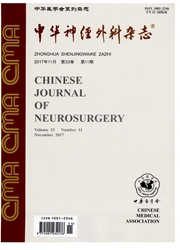

 中文摘要:
中文摘要:
目的探讨双额大骨瓣减压术对脑外伤后难治性弥漫性脑肿胀的治疗效果、手术时机与方式及并发症的防治。方法回顾性分析重型颅脑损伤后难治性脑肿胀25例,其中双额大骨瓣减压组14例,保守治疗组11例。所有患者入院时行CT检查、颅内压监测、降颅压治疗。双额大骨瓣减压组入院后在不同时间内接受双额大骨瓣减压术,术后继续颅内压监测;保守治疗组一直采用保守治疗降低颅内压,持续性颅内压监测。在出院后6个月随访,进行GOS评分并统计双额大骨瓣减压术患者的并发症。结果入院时双额去骨瓣减压组的GCS为(5.6±1.9)分;保守治疗组的GCS为(5.8±1.7)分。双额大骨瓣减压组人院时颅内压为(35.8±6.8)mmHg,从入院到手术平均时间为10.1h(2—18h),手术后明显降低为(17.6±5.7)mmHg(P〈0.05),保守治疗组入院时的颅内压为(33.2±5.6)mmHg,入院后10.1h时颅内压降低为(30.2±4.9)mmHg(P〉0.05),与双额大骨瓣减压组术后颅内压相比差异有统计学意义(P〈0.05)。双额大骨瓣减压组术后并发症包括:硬膜下积液2例,术后脑积水1例。出院后6个月随访GOS评分:双额大瓣减压组预后较好有6例(GOS4~5分),预后较差有8例(GOS1~3分);保守治疗组预后较好有2例(COS4—5分),预后较差有9例(COSl一3分)。结论双额大骨瓣减压术对于脑外伤后难治性弥漫性脑肿胀是一种快速有效降低颅内压的方法,可改善患者预后。手术时机是影响预后的关键,术中减张严密缝合硬脑膜可减少术后并发症的发生。
 英文摘要:
英文摘要:
Objective To analyze the effects of bifrontal decompressive craniectomy on patients with refractory brain swelling after severe traumatic brain injuries. Methods We retrospectively reviewed 25 patients with refractory brain swelling after severe head injuries. Bifrontal decompressive craniectomy was carried out in 14 patients while the other 11 patients were nursed with non - operative treatments. All patients were managed by the intracranial pressure monitoring. The Glasgow Outcome Scale (GOS) at the 6 - months followup was used as the outcome measure. Results The admission ICP in the operative group was ( 35.8 ± 6. 8) mm Hg, which fell to ( 17.6 ± 5.7) mm Hg after the operation. In the non - operative group, ICP fell from (33.2 ±5.6) mm Hg to (30. 2 ±4. 9) mm Hg 10. 1 h after the admission. 6 of the 14 patients in the operative group scored between 4 - 5 on the GOS compared with 2 of the 11 patients in the non - operative group. Conclusions Bifrontal decompressive craniectomy was a suitable measure to decrease the ICP in the patients with refractory brain swelling. If carried out early, it could provide better outcome for these patients.
 同期刊论文项目
同期刊论文项目
 同项目期刊论文
同项目期刊论文
 Hydrogen-rich water protects against ischemic brain injury in rats by regulating calcium buffering p
Hydrogen-rich water protects against ischemic brain injury in rats by regulating calcium buffering p Quantitative computer tomography analysis of post-operative subdural fluid volume predicts recurrenc
Quantitative computer tomography analysis of post-operative subdural fluid volume predicts recurrenc 期刊信息
期刊信息
